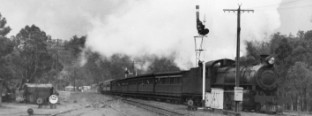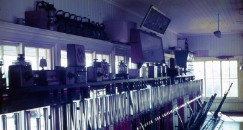East Fremantle
WAGR - Eastern Railway (E. R.) | |
Mileage: ? | |
Next Down Station: | Next Up Station: |
Quick Facts | |
Opened | Closed |
1896 | 26/11/1905 |
Mechanical | Electrical |
30 Levers | Sykes Lock & Block |
Fate: Unknown - Superceded by EFGJ Box | |
East Fremantle signal cabin was situated on the Eastern Railway between the busy terminus station of Fremantle (Cliff Street) and the timber rail bridge which led to North Fremantle on the opposite side of the Swan River. It served a vital function during its short life as it was a major three-way junction directing passenger, mail and goods trains into and out of the bustling Fremantle Harbour area. Despite it's importance however, the cabin was destined for a relatively short life, yet one which was marked by frequent changes to operating equipment and systems.
The exterior photo shows the view along the platform lines at East Fremantle. The station and Signal Cabin were very much a 'standard' W. A. G. R. design. No. 2 Down Home Signal can just be seen at the far end of the right hand (Down) platform.
East Fremantle station opened on Sunday, 30th August, 1896, as an Electric Staff Station. The new single line section being created therefore being between East Fremantle and North Fremantle. Semaphore signals were also erected here in 1896. Shortly afterwards Point Indicators were fitted to three sets of points in the yard (as shown on the diagram below) and these then displayed the 1896 Point Indicator colour scheme, being "...a White disc by day and a White light by night for the Main Line, and the Red disc by day and a Red light by night for Siding..." introduced on Sept. 3rd, 1896.
"The Line Duplicated." The Daily News of 23/02/1897 boldly announced that after much work:
In addition to the Absolute Block working between North Fremantle and East Fremantle, "Section Clear but Station or Junction Blocked" working was in force on the "UP Journey" (towards East Fremantle from North Fremantle). This was a form of verbal warning which was required to be given to the Driver of any 'Up' train in the case of a train still being in the station at East Fremantle (in the case of it not being past the Starting Signal there), or if the Junction into the Goods yard was still fouled by a previous train. A Driver given such a warning would then be aquainted of the circumstances and control his train accordingly.
On the 29th July 1902, part of the operating system used at this signal cabin was changed over from Winter's Block to Sykes Lock and Block using Sykes Terminal Instruments on both Up and Down Main Lines. Cancelling Keys (Marked "A" for Transmitting and "B" for Receiving) were provided, with an additional "B" key to South Quay cabin. With the installation between Fremantle (Cliff Street) and North Fremantle (Cabin 'A') confirmed by entries in Weekly Notice No. 31 of 1902, this would seem to indicate that this was the first use of Sykes Lock and Block instruments in Western Australia.
This diagram was based on W. A. G. R. Drawing EE680/01 dated 29th April, 1902 and signed by Signal Engineer Harold Dowson and shows the layout of the points, signals and 'Treadles' for the operation of the Sykes instruments. Note what must have been a fine array of bracket signals. The bracket Up Home Signals 23, 26, 29 and the trine bracket Up Distant signals 24, 27 and 30. The centre post of No. 27 signal also carried the North Fremantle No. 1 Distant signal, applying to the 'Down' direction.
Winter's Blockremained in use between East Fremantle and North Fremantle (Cabin 'A') until the 1st September 1902, when the Sykes Lock and Block system of working was extended to North Fremantle and the Sykes Terminal Instruments at East Fremantle were replaced with ordinary Sykes Through Instruments.
Along with the South Quay signal cabin, East Fremantle signal cabin was closed on 26th November, 1905 being replaced on that day by a single signal cabin called East Fremantle Goods Junction Box. During the transition between the old Fremantle (Cliff Street) station and the then new (present day) Fremantle station, the signals at East Fremantle passenger station were worked by 'pull-over' levers until these too were taken out of service on 1st July, 1907.
Any additional information on this signal cabin would be most welcome - please use the e-mail form provided on this page.
Information researched and interpreted by Chris. J. E. French of SignallingWA
Buy this page or View your SignallingWA Shopping Cart
This page is copyright, and permission must be sought from SignallingWA before this page is used for any purpose other than personal education.
EAST FREMANTLE Employees | ||
This list may not be complete and does not yet include employees who worked here without being appointed. Where an appointment date is unknown, the Weekly Notice (WN) date advising of the appointment or other official documentation, i.e. Certificate of Competency (CC) will be used. | ||
Name | Appointed | Position |
| Barrett, E. | 01/07/1893 until November 1897 | Officer-in-Charge |
| Hicks, Ernest | 22/02/1897 | Night Signalman |
| Seckold, H. G. | 22/02/1897 | Signalman |
| Wilson, Fred | 22/02/1897 | Signalman |
| Seubert, Arnot D. | 20/08/1897 | Signalman |
| Heal, E. W. | 26/09/1897 | Signalman |
| O'Neill, R. G. | November 1897 until March 1900 | Station Master |
| Dunn, Patrick | 01/11/1897 | Signalman |
| Dunn, Patrick | 01/09/1898 | Night Officer |
| Bicknell, Dan F. | 25/10/1898 | Signalman - 3rd Class |
| Dwyer, William | 08/09/1899 | Signalman - 3rd Class |
| Dutton, H. | March 1900 until March 1901 | Officer-in-Charge |
| Ryan, R. C. | March 1901 until November 1902 | Officer-in-Charge |
| Smith, H. | November 1902 until May 1903 | Officer-in-Charge |
| Dunn, P. | May 1903 until July 1904 | Officer-in-Charge |
| Spong, William J. | 08/04/1904 | Signalman - 3rd Class |
| Paul, P. R. | July 1904 until February 1905 | Officer-in-Charge |
| Crockett, P. | February 1905 until 01/07/1907 | Officer-in-Charge |
| Evans, Edward | 24/08/1905 | Signalman - 3rd Class |
| East Fremantle Station Closed on 01/07/1907 when the New Fremantle Station Opened. | ||
Is a name missing? Please submit any corrections / additions with suitable evidence using the e-mail form above. | ||


